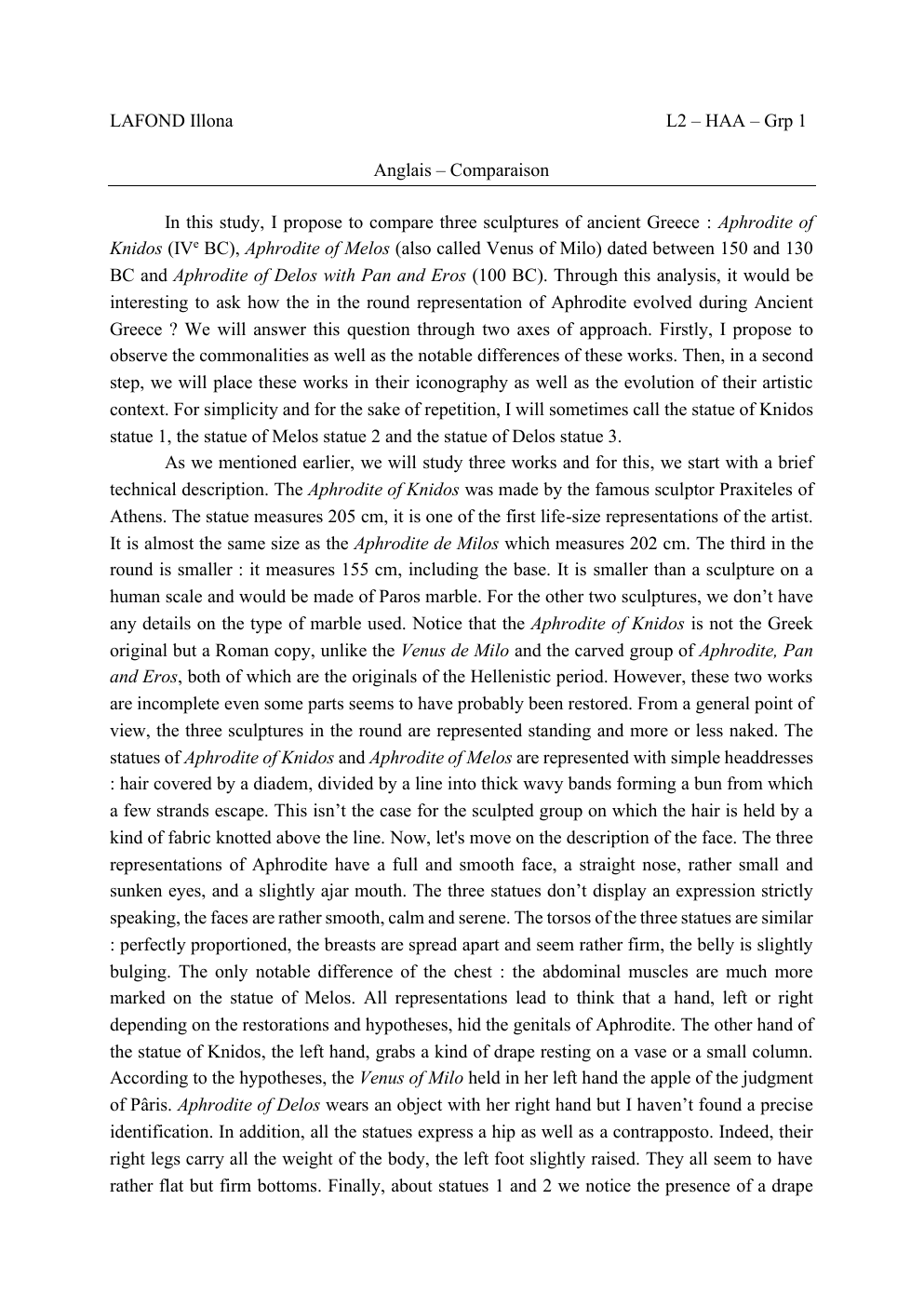Comparaison œuvres anglais
Publié le 03/06/2022
Extrait du document
«
L2 – HAA – Grp 1
LAFOND Illona
Anglais – Comparaison
In this study, I propose to compare three sculptures of ancient Greece : Aphrodite of
Knidos (IVe BC), Aphrodite of Melos (also called Venus of Milo) dated between 150 and 130
BC and Aphrodite of Delos with Pan and Eros (100 BC).
Through this analysis, it would be
interesting to ask how the in the round representation of Aphrodite evolved during Ancient
Greece ? We will answer this question through two axes of approach.
Firstly, I propose to
observe the commonalities as well as the notable differences of these works.
Then, in a second
step, we will place these works in their iconography as well as the evolution of their artistic
context.
For simplicity and for the sake of repetition, I will sometimes call the statue of Knidos
statue 1, the statue of Melos statue 2 and the statue of Delos statue 3.
As we mentioned earlier, we will study three works and for this, we start with a brief
technical description.
The Aphrodite of Knidos was made by the famous sculptor Praxiteles of
Athens.
The statue measures 205 cm, it is one of the first life-size representations of the artist.
It is almost the same size as the Aphrodite de Milos which measures 202 cm.
The third in the
round is smaller : it measures 155 cm, including the base.
It is smaller than a sculpture on a
human scale and would be made of Paros marble.
For the other two sculptures, we don’t have
any details on the type of marble used.
Notice that the Aphrodite of Knidos is not the Greek
original but a Roman copy, unlike the Venus de Milo and the carved group of Aphrodite, Pan
and Eros, both of which are the originals of the Hellenistic period.
However, these two works
are incomplete even some parts seems to have probably been restored.
From a general point of
view, the three sculptures in the round are represented standing and more or less naked.
The
statues of Aphrodite of Knidos and Aphrodite of Melos are represented with simple headdresses
: hair covered by a diadem, divided by a line into thick wavy bands forming a bun from which
a few strands escape.
This isn’t the case for the sculpted group on which the hair is held by a
kind of fabric knotted above the line.
Now, let's move on the description of the face.
The three
representations of Aphrodite have a full and smooth face, a straight nose, rather small and
sunken eyes, and a slightly ajar mouth.
The three statues don’t display an expression strictly
speaking, the faces are rather smooth, calm and serene.
The torsos of the three statues are similar
: perfectly proportioned, the breasts are spread apart and seem rather firm, the belly is slightly
bulging.
The only notable difference of the chest : the abdominal muscles are much more
marked on the statue of Melos.
All representations lead to think that a hand, left or right
depending on the restorations and hypotheses, hid the genitals of Aphrodite.
The other hand of
the statue of Knidos, the left hand, grabs a kind of drape resting on a vase or a small column.
According to the hypotheses, the Venus of Milo held in her left hand the apple of the judgment
of Pâris.
Aphrodite of Delos wears an object with her right hand but I haven’t found a precise
identification.
In addition, all the statues express a hip as well as a contrapposto.
Indeed, their
right legs carry all the weight of the body, the left foot slightly raised.
They all seem to have
rather flat but firm bottoms.
Finally, about statues 1 and 2 we notice the presence of a drape.
»
↓↓↓ APERÇU DU DOCUMENT ↓↓↓
Liens utiles
- Le sévère blocus que veulent établir les Anglais ne produira aucun résultat. Napoléon Bonaparte, ?uvres, tome II
- Comparaison entre les œuvres de RONSARD et celles de VILLON
- Etudiez la comparaison d'un même passage des deux œuvres : la lettre 125 du roman et le chapitre 22 du film (La présidente de Tourvel se donne à Valmont)
- Comparaison de deux œuvres : « Moderato Cantabile » de Marguerite Duras et « Rouge sur blanc » de Robert Reumont.
- Description et comparaison de deux œuvres : La Chute d'Icare de Peter Bruegel et Punishment de Guillaume Leblon











